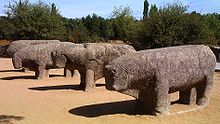Porca da Vila
Porca da Vila (also “berrão” or “berroa”; Spanish Verraco or “Verraco de piedra”) are proto-historical, zoomorphic figures whose former meaning is unclear. 16 of them were found in the northern Portuguese province of Trás-os-Montes and many others in the neighboring Spanish provinces of Salamanca and Zamora . The elongated animals have short legs and many were beheaded in early Christian times (Porca de Vila dos Sinos).
In the walled medieval urban area of Bragança is near the castle of the Pelourinho (stake). The symbol of medieval municipal sovereignty usually consists of a column crowned by a capital. In this case it pierces the iron or Roman granite statue of one of the pig sculptures known in the country as Porca da Vila .
A comparable sculpture is set up in Torre de Dona Chama next to the Pelourinho and the Porca de Murça is also known. In the neighboring regions, sculptures of other animal species have been created and placed in the same way. Mostly they are understood as boars or bulls and form regional groups.
literature
- Joaquim R. dos Santos Júnior: Berroes proto-históricos no Nordeste de Portugal . Assuntos Culturais, Lisbon 1975, pp. 29-34.

